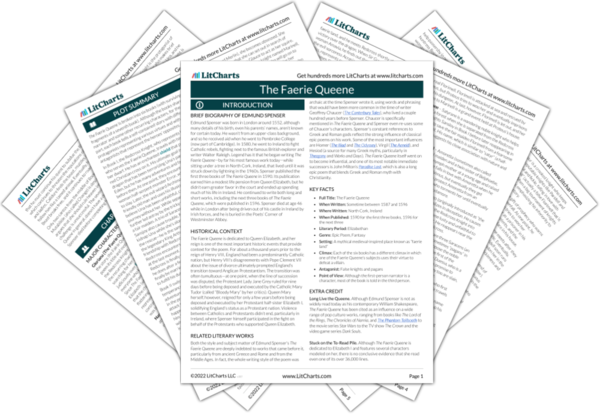Edmund Spenser’s The Faerie Queene begins with a grand dedication to Queen Elizabeth (the reigning monarch in Britain at the time) in which he writes that all the labor that went into his poem is dedicated to her. The character of the Faerie Queene herself (also called Queen Gloriana) is always virtuous and correct, making her a flattering stand-in for the real-life Queen Elizabeth. Other characters also have clear parallels to Elizabeth, such as the chaste but powerful knight Britomart, who is famously a virgin like Elizabeth and whose very name seems to suggest Britain. Britomart is in fact British, and when she fights on behalf of her homeland, it’s no accident that she defeats every evil knight she encounters and astonishes many with her beauty.
While the flattering portrayals of Queen Elizabeth are the most notable examples of British nationalism in Spenser’s epic poem, The Faerie Queene also explores and glorifies British identity in other ways. One of the most noteworthy and unusual cantos in the poem is Book II, Canto X, where the action temporarily pauses while the noble knight Sir Guyon reads a long account of British history. Like The Faerie Queene itself, the book that Guyon reads freely mixes real history with mythology, portraying England as an ancient land of giants and monsters that endured numerous reversals of fortune and changes in leadership before finally arriving at its glorious modern form. Spenser invokes Britain’s connections to both mythology and an ancient past, not only to praise Queen Elizabeth, but also to help foster a sense of British identity and tradition that endured well beyond Elizabeth’s reign.
British Identity and Nationalism ThemeTracker

British Identity and Nationalism Quotes in The Faerie Queene
Lo I the man, whose Muse whilome did maske,
As time her taught in lowly Shepheards weeds,
Am now enforst a far unfitter taske,
For trumpets sterne to chaunge mine Oaten reeds,
And sing of Knights and Ladies gentle deeds;
A Gentle Knight was pricking on the plaine,
Y clad in mightie armes and silver shielde,
Wherein old dints of deepe wounds did remaine,
The cruel markes of many a bloudy fielde;
[…]
But on his brest a bloudie Crosse he bore,
The dear remembrance of his dying Lord,
For whose weete sake that glorious badge he wore,
And dead as living ever him ador’d:
Upon his shield the like was also scor’d
His carriage was full comely and upright,
His countenance demure and temperate,
But yet so sterne and terrible in sight,
That cheard his friends, and did his foes amate:
He was an Elfin borne of noble state
[…]
Him als accopanyd upon the way
A comely Palmer, clad in blacke attire,
Of ripest years, and haries all hoarie gray
After him Uther, which Pendragon hight,
Succeeding There abruptly did end
It falls me here to write of Chastity
That fairest virtue, farre above the rest;
For which what needs me fetch from Faery
Forreine ensamples, it to have exprest?
Sith it is shrined in my Soveraines brest
The man whom Heavens have ordaynd to bee
The spouse of Britomart, is Arthegall:
He wonneth in the land of Fayeree
Though now their acts be no where to be found
As that renowned Poet them compyled,
With warlike numbers and Heroicke sound,
Dan Chaucer well of English undefiled,
On Fames eternall beadroll worthie to be fyled.
And such was he, of whome I have to tell,
The Champion of true Justice Artegall.
Whom (as ye lately mote remember well)
An hard adventure, which did then befall,
Into redoubted perill forth did call.
Where being layd, the wrothfull Britonesse
Stayd not, till she came to her selfe againe,
But in revenge both of her loves distresse,
And her late vile reproach, though vaunted vaine,
And also of her wound, which sore did paine,
She with one stroke both head and helmet cleft.
When they had seene and heard her doome a rights
Against Duessa, damned by them all;
But by her tempred without griefe or gall,
Till strong constraint did her thereto enforce.
But ere he could reform it thoroughly,
He through occasion called was away,
To Faerie Court, that of necessity
His course of Justice he was forst to stay,
And Talus to revoke from the right way
Ne may this homely verse, of many meanest,
Hope to escape his venomous despite,
More than my former writes, all were they clearest
From blamefull blot, and free from all that wite,
With which some wicked tongues did it backebite,
and bring into a mighty Peres displeasure,
That never so deserved to endite.
Therefore do you my rimes keep better measure,
And seeke to please, that now is counted wisemens threasure.











